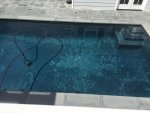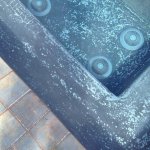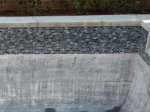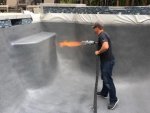The problem of plaster spotting has been an ongoing puzzle and controversy in the swimming pool industry for over three decades. The generally round, smooth-yet-unsightly white soft spots in new plaster pools have long been a source of contention among pool plasterers, and pool chemical service firms or pool owners, each blaming the other for the phenomenon.
From 1999 to 2003, onBalance provided several case studies to the plastering industry (performed by two respected cement labs) on white spotting (which some incorrectly name it "spot etching"). It was determined that white spotting was caused by several contributory elements, all due to improper plastering practices: too much calcium chloride added as a set accelerant; adding water to the hardening plaster surface; trowel-pressing the added water into the surface, creating porosity and micro-cracking in localized areas or spots, allowing for later water penetration deep into the plaster matrix; subsequent “rinsing” (non-aggressive leaching) of soluble plaster components (calcium hydroxide and calcium chloride) from the thus-compromised surface, and late hard troweling.
Over the course of the past year, onBalance undertook an additional project to help provide more definitive and sufficient evidence as to the cause.
A one year old spotted pool in Los Angeles was inspected by both an onBalance partner and by a pool plastering industry advocate (who incorrectly describes it as "spot etching" or "etching deterioration.") Both had produced written opinions on the pool in question, with the former implicating defective plastering workmanship and the latter implicating aggressive water chemistry.

At that point, onBalance drained the pool, and with representatives of the trade press, service members, and pool plasterers present, core sampled the pool, obtaining dozens of cores from a local area of a spotted pool wall. These samples were sent to four different cement failure-analysis laboratories for petrographic examination. Results have been obtained from Construction Technologies Laboratories (a subsidiary of the Portland Cement Association), the RJ Lee Group, Riverbend Petrographics, and Wiss, Janney, Elstner. Would these highly respected labs find consensus when independently analyzing plaster cores containing white spots from the same pool?
All four labs have now submitted reports on their analysis. Here is a summary of their findings:
1. The pool plaster contained more than 3 percent calcium chloride dehydrate, which is detrimental. (The allowable maximum is two percent, and zero for colored plaster).
2. The whitish spots were smooth to the touch, but under a microscope, the spots were shown to be porous, permeable, structurally weak and soft, with an abundance of micro-cracking and a high water-to-cement ratio.
3. The depth of the micro-cracking and porosity within the spots went as deep as 5 mm (.2 in. or 3/16th) and a diameter (width) of 15 mm (.6 in.)
4. The unaffected surface (cement paste) surrounding the spots was dense, hard, and smooth, and did not have a high water-to-cement ratio, the porosity, or the micro-cracking as found in the spots.
5. There was no evidence of aggressive water or chemical attack (relative to calcium carbonate) causing the spots. The surface surrounding the spots was not etched, but instead had been “carbonated” which provided further evidence that the surface had not been etched by aggressive water.
6. The improper adding of water during plaster finishing (troweling) causes excess porosity and micro-cracking within the spots. This in turn, provides an avenue (breach) for pool water to penetrate deeper into the plaster matrix and access soluble compounds causing continued loss of plaster material.
As indicated above, improper water chemistry did not cause the white spotting, and therefore, it should not be called "spot etching" or "etching deterioration." In fact, balanced pool water – and even water with a positive CSI value – will not stop this process from happening to a defective plaster surface. And depending on the severity of the improper plastering practices, spotting may occur within a week, but usually not until a few months down the road.
White spots have a smooth, yet porous surface. This is due to the loss of two soluble plaster components (calcium chloride and calcium hydroxide which comprise of about 15 – 20 percent of the cement) interspersed throughout the more durable materials. This results in a weakened, soft, and self-deteriorating surface. Porosity, and subsequent carbonation, creates a lighter (whiter) color in contrast to the surrounding denser and unaffected plaster surface.
While white soft spotting is somewhat visible in white plaster pools, it becomes more unsightly when the surrounding surface is off-white and slightly gray due to excess calcium chloride being added to the plaster mix. And since the spots are more porous than the surrounding plaster, it can also absorb copper or iron and become aqua or brown instead of white. Spotting is especially visible and objectionable when it occurs in dark colored plaster and colored quartz pools.
By comparison, aggressive water attacks and removes most plaster compounds from a dense and smooth surface, thereby causing a uniformly etched and roughened surface, similar to fine sandpaper, and with no significant change in color. As is known, when dark colored plaster pools are given various types of acid treatments, they do not turn white, nor do they spot.
The plastering industry has no study that proves that aggressive water causes random white spotting (or spot etching) on quality pool plaster. There seems to be little doubt that the cause of plaster spotting has been discovered, analyzed, identified and documented. See these threads: How White Pool Plaster Turns Blotchy
High CYA Levels Do Not Stain Plaster
For more information, see the following post: Being Blamed for Plaster Discolorations? Don't Get Hoodwinked
scientific-evidence-on-plaster-spotting-t57853.html
And: aggressive-water-versus-improper-pool-plastering-t51900.html
For proper plastering practices, see this post: ten-guidelines-for-quality-pool-plaster-t42957.html
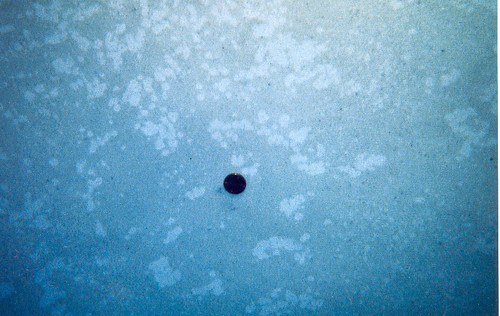
For another helpful picture of white spotting, see this thread: http://www.troublefreepool.com/threads/75287-Plaster-mottling-normal?p=690714#post690714
From 1999 to 2003, onBalance provided several case studies to the plastering industry (performed by two respected cement labs) on white spotting (which some incorrectly name it "spot etching"). It was determined that white spotting was caused by several contributory elements, all due to improper plastering practices: too much calcium chloride added as a set accelerant; adding water to the hardening plaster surface; trowel-pressing the added water into the surface, creating porosity and micro-cracking in localized areas or spots, allowing for later water penetration deep into the plaster matrix; subsequent “rinsing” (non-aggressive leaching) of soluble plaster components (calcium hydroxide and calcium chloride) from the thus-compromised surface, and late hard troweling.
Over the course of the past year, onBalance undertook an additional project to help provide more definitive and sufficient evidence as to the cause.
A one year old spotted pool in Los Angeles was inspected by both an onBalance partner and by a pool plastering industry advocate (who incorrectly describes it as "spot etching" or "etching deterioration.") Both had produced written opinions on the pool in question, with the former implicating defective plastering workmanship and the latter implicating aggressive water chemistry.

At that point, onBalance drained the pool, and with representatives of the trade press, service members, and pool plasterers present, core sampled the pool, obtaining dozens of cores from a local area of a spotted pool wall. These samples were sent to four different cement failure-analysis laboratories for petrographic examination. Results have been obtained from Construction Technologies Laboratories (a subsidiary of the Portland Cement Association), the RJ Lee Group, Riverbend Petrographics, and Wiss, Janney, Elstner. Would these highly respected labs find consensus when independently analyzing plaster cores containing white spots from the same pool?
All four labs have now submitted reports on their analysis. Here is a summary of their findings:
1. The pool plaster contained more than 3 percent calcium chloride dehydrate, which is detrimental. (The allowable maximum is two percent, and zero for colored plaster).
2. The whitish spots were smooth to the touch, but under a microscope, the spots were shown to be porous, permeable, structurally weak and soft, with an abundance of micro-cracking and a high water-to-cement ratio.
3. The depth of the micro-cracking and porosity within the spots went as deep as 5 mm (.2 in. or 3/16th) and a diameter (width) of 15 mm (.6 in.)
4. The unaffected surface (cement paste) surrounding the spots was dense, hard, and smooth, and did not have a high water-to-cement ratio, the porosity, or the micro-cracking as found in the spots.
5. There was no evidence of aggressive water or chemical attack (relative to calcium carbonate) causing the spots. The surface surrounding the spots was not etched, but instead had been “carbonated” which provided further evidence that the surface had not been etched by aggressive water.
6. The improper adding of water during plaster finishing (troweling) causes excess porosity and micro-cracking within the spots. This in turn, provides an avenue (breach) for pool water to penetrate deeper into the plaster matrix and access soluble compounds causing continued loss of plaster material.
As indicated above, improper water chemistry did not cause the white spotting, and therefore, it should not be called "spot etching" or "etching deterioration." In fact, balanced pool water – and even water with a positive CSI value – will not stop this process from happening to a defective plaster surface. And depending on the severity of the improper plastering practices, spotting may occur within a week, but usually not until a few months down the road.
White spots have a smooth, yet porous surface. This is due to the loss of two soluble plaster components (calcium chloride and calcium hydroxide which comprise of about 15 – 20 percent of the cement) interspersed throughout the more durable materials. This results in a weakened, soft, and self-deteriorating surface. Porosity, and subsequent carbonation, creates a lighter (whiter) color in contrast to the surrounding denser and unaffected plaster surface.
While white soft spotting is somewhat visible in white plaster pools, it becomes more unsightly when the surrounding surface is off-white and slightly gray due to excess calcium chloride being added to the plaster mix. And since the spots are more porous than the surrounding plaster, it can also absorb copper or iron and become aqua or brown instead of white. Spotting is especially visible and objectionable when it occurs in dark colored plaster and colored quartz pools.
By comparison, aggressive water attacks and removes most plaster compounds from a dense and smooth surface, thereby causing a uniformly etched and roughened surface, similar to fine sandpaper, and with no significant change in color. As is known, when dark colored plaster pools are given various types of acid treatments, they do not turn white, nor do they spot.
The plastering industry has no study that proves that aggressive water causes random white spotting (or spot etching) on quality pool plaster. There seems to be little doubt that the cause of plaster spotting has been discovered, analyzed, identified and documented. See these threads: How White Pool Plaster Turns Blotchy
High CYA Levels Do Not Stain Plaster
For more information, see the following post: Being Blamed for Plaster Discolorations? Don't Get Hoodwinked
scientific-evidence-on-plaster-spotting-t57853.html
And: aggressive-water-versus-improper-pool-plastering-t51900.html
For proper plastering practices, see this post: ten-guidelines-for-quality-pool-plaster-t42957.html

For another helpful picture of white spotting, see this thread: http://www.troublefreepool.com/threads/75287-Plaster-mottling-normal?p=690714#post690714
Last edited:


